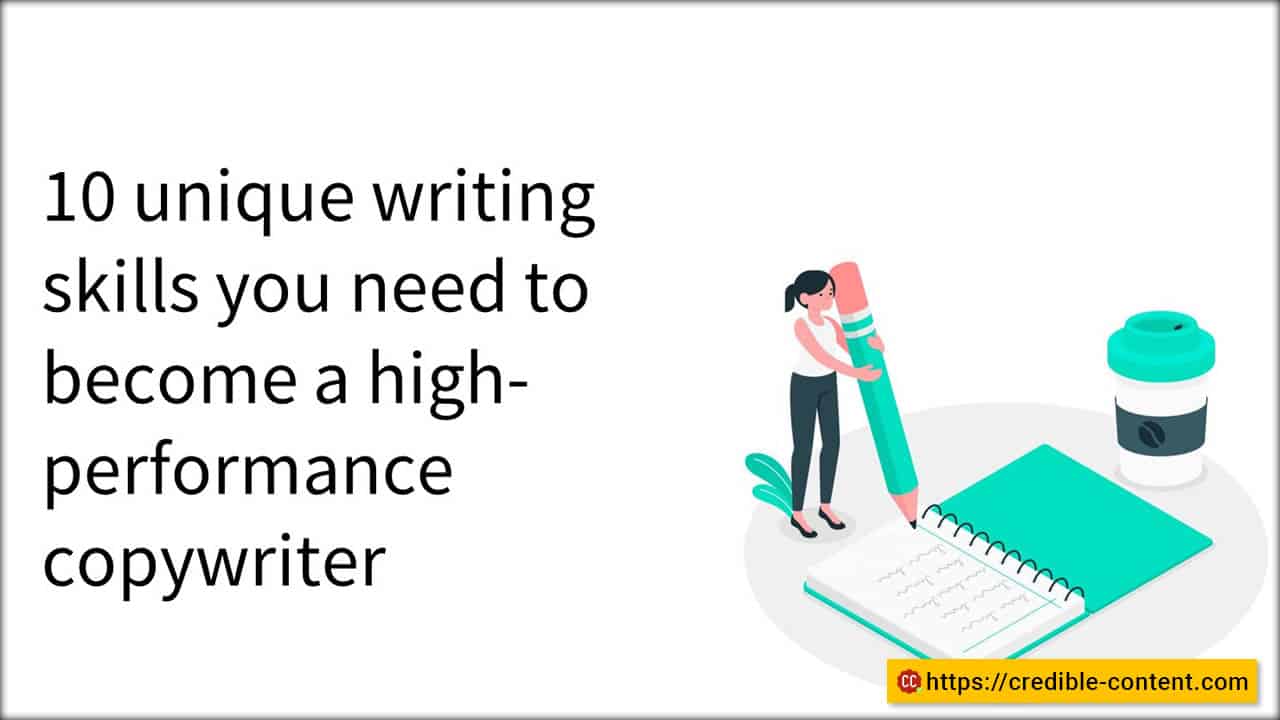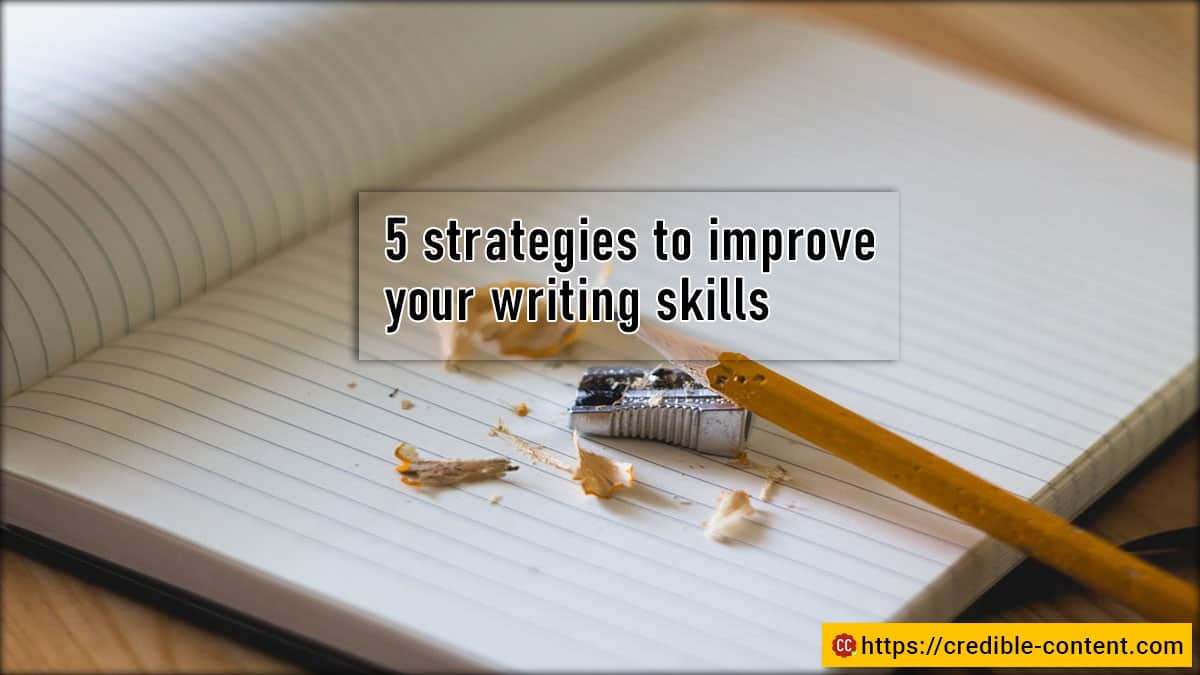Imagine this: You come across a captivating advertisement that instantly grabs your attention.
The words flow effortlessly. It strongly conveys the essence of the brand. Taking action becomes irresistible.
You are compelled to buy the product, visit the website, or engage with the brand, depending on the CTA.
What’s the secret behind such a powerful messaging?
It’s the skillful art of copywriting. At the core of skillful copywriting are the fundamental writing skills.
Writing skills are the backbone of effective copywriting. With your writing skills, you can transform ordinary words into persuasive, engaging, and memorable messages.
Attention spans are fleeting, and competition is fierce in the world of advertising and marketing. The importance of writing skills for the purpose of grabbing attention cannot be overstated.
Whether it’s a catchy headline, a compelling product description, or a persuasive call to action, every word counts.
With your strong writing skills, you can craft messages that resonate with your target audience, spark emotions, and drive desired actions.
As a persuasive copywriter, you should be able to choose the right words, structure sentences effectively, and weave storytelling into the copy. Together, they create a powerful connection between brands and consumers.
Skilled copywriters understand the psychology of persuasion and employ persuasive techniques to influence readers and elicit a response.
Well-developed writing skills are the cornerstone of success in copywriting. They are the keys that unlock the door to engage a, persuasive, and memorable brand messaging.
As a successful copywriter, you should be able to craft compelling headlines that grab attention. You must be able to write persuasively and engagingly to make a connection with your target audience. You should be able to tell captivating stories that resonate with readers and spark emotions. Also, you should have a knack for writing concise and impactful copy that gets the message across effectively.
Adapting your writing style to different mediums and platforms is one of the key skills as a copywriter.
Listed below are 7 writing skills you need to develop to become a successful copywriter.
1. Master language and grammar to become a successful and skilled copywriter
- Clear and concise writing
- Proper grammar and punctuation
- Effective sentence structure
For skillful copywriting, having a strong command of language and grammar is crucial. These skills form the foundation of effective communication and enable you to craft compelling copy that captures attention and rights action.
Here are some copywriting tips to help you master language and grammar for impactful writing.
Clear and concise writing
- Keep your sentences and paragraphs short and focused to maintain clarity.
- Use simple and straightforward language that is easy for your target audience to understand.
- Avoid unnecessary jargon and complex terminology that may confuse or alienate your readers.
- Eliminate any redundant or repetitive words to make your copy more concise and impactful.
Proper grammar and punctuation
- Ensure that your writing adheres to the rules of grammar, including correct verb tenses, subject-verb agreement, and consistent pronoun usage.
- Use punctuation marks correctly to enhance the flow and readability of your copy.
- Proofread your work thoroughly to catch any grammatical errors or typos before finalizing your copy.
Effective sentence structure
- Vary your sentence structure to create rhythm and maintain reader engagement.
- Use a mix of short and long sentences to add variety and impact to your writing.
- Start sentences with strong verbs and compelling adjectives to grab attention.
- Pay attention to parallelism in your sentences, ensuring that similar ideas are expressed in a consistent manner.
Good copywriting is not just about creativity and persuasion; it also requires a solid foundation of language and grammar skills. By mastering language and grammar in your copywriting, you can effectively convey your message and connect with your audience.
By continuously improving your writing abilities, you can become a proficient copywriter capable of delivering impactful and compelling messages that resonate with your target audience.
2. Nurture creativity and originality to become a successful copywriter
- Ability to generate unique and compelling ideas.
- Innovative approaches to messaging and storytelling.
- Thinking outside the box to capture audience attention.
For being a proficient copywriter, creativity and originality are vital to capturing the attention of your audience and standing out in a crowded marketplace. To create compelling and engaging copy, consider the following copywriting tips that highlight the importance of creativity and originality in your work:
Ability to generate unique and compelling ideas
- Embrace brainstorming sessions to generate fresh ideas and concepts.
- Research your target audience to understand their interests, needs, and preferences.
- Find unique angles and perspectives that differentiate your brand from competitors.
- Incorporate innovative elements that resonate with your audience and align with your brand identity.
Innovative approaches to messaging and storytelling
- Experiment with different storytelling techniques to make your copy more memorable.
- Use creative metaphors, analogies, or vivid descriptions to evoke emotions.
- Integrate storytelling elements that connect with your audience on a deeper level.
- Tailor your messaging to address specific pain points or aspirations of your target audience.
Thinking outside the box to capture audience attention
- Challenge conventional thinking and explore unconventional ideas to grab attention.
- Take risks and be bold with your messaging to create a lasting impact.
- Use unexpected or provocative headlines to pique curiosity.
- Incorporate humor, surprise, or intrigue to make your copy more engaging.
In the world of copywriting, creativity and imagination are your secret weapons. They allow you to break through the noise and captivate your audience’s attention.
Unleash your creative powers to be original. Let your copy shine with creativity and originality.
3. Persuasive writing techniques that can make you a successful copywriter
- Understanding the target audience and their motivations.
- Utilising persuasive language and rhetoric.
- Creating persuasive arguments and call-to-action.
Persuasive writing is a type of writing that is designed to convince the reader to take a certain action believe a certain thing. Persuasive writing is often used in advertising, marketing, and politics.
Some quick persuasive writing tips
- Use strong verbs.
- Avoid passive voice.
- Use specific examples to illustrate your points.
- Keep your sentences short and to the point.
- Proofread your work carefully before submitting it.
Delving deeper…
Understanding the target audience and their motivations
- Know your audience: Dive deep into understanding your target audience. Research their demographics, preferences, and pain points. Uncover what motivates them and drives their decision-making process.
- Empathy is key: Put yourself in your audiences shoes. Understand their desires, fears, and aspirations. Address directly to their needs and show that you generally understand and care about their concerns.
- Tailor your message: Craft your writing to resonate with your specific audience. Use language, tone, and examples that are relatable and meaningful to them. Make them feel like you’re speaking directly to them.
Utilising persuasive language and rhetoric
- Use power words: Choose impactful and emotionally-charged words that evoke a response. Words like “exclusive”, “irresistible”, or “transformative” create a sense of urgency and desire.
- Create vivid imagery: Paint a picture with your words. Use descriptive language that engages the senses and sparks imagination. Help your audience visualize the benefits and outcomes they can experience.
- Appeal to emotions: Connect with your audience on an emotional level. Tap into their desires, dreams, and pain points. Craft compelling stories and narratives that resonate with their emotions and create a sense of urgency.
Creating persuasive arguments and calls to action
- Provide social proof: Highlight testimonials, case studies, or success stories to demonstrate the credibility and effectiveness of your product or service. Show that others have experienced positive results, building trust and confidence.
- Present strong evidence: Support your claims with facts, statistics, or research findings. This adds credibility and authority to your arguments, making them more persuasive.
- Anticipate objections: Address potential concerns or objections your audience may have. Provocatively provide counterarguments and solutions to alleviate their doubts and build trust.
- Craft a compelling call to action: Clearly state what you want your audience to do next. Use action-oriented language and create a sense of urgency. Make it easy for them to take the desired action by providing clear instructions.
4. Research and Analysis: The blueprint for copywriting success
- Conducting thorough research on products/services and target market.
- Analyzing competitors and industry trends.
- Incorporating data and insights into copywriting strategy.
By conducting thorough research, analyzing competitors, and incorporating data and insights into your copywriting strategy, you position yourself for success.
The more you understand your product, target market, competitors, and industry trends, the more persuasive and impactful your copy will be. Invest time in research and analysis, and watch your copy captivate your audience and drive desired actions.
Become a copywriting expert by mastering the art of research and turning insights into compelling copy.
Conducting thorough research on products/services and target market
- Dive deep into product knowledge: Understand the features, benefits, and unique selling points of the product or service you’re writing about. This enables you to highlight its value and address customer pain points effectively.
- Know your target market: Research the demographics, preferences, and behaviors of your target audience. Identify their needs, desires, and challenges. This knowledge forms the foundation for persuasive copy that resonates with them.
- Gather customer insights: Conduct surveys, interviews, or analyze customer feedback to gain valuable insights. Understand their motivations, objections, and aspirations. Use these insights to create copy that speaks directly to their needs.
Analyzing competitors and industry trends
- Study your competition: Analyze the messaging and strategies of your competitors. Identify their unique selling propositions and areas where you can differentiate. This helps you position your product or service effectively.
- Stay updated with industry trends: Keep a finger on the pulse of your industry. Follow industry publications, blogs, and attend conferences to stay informed about the latest trends, innovations, and customer preferences. This knowledge allows you to create timely and relevant copy.
Incorporating data and insights into copywriting strategy
- Use data to inform decisions: Utilize data analytics and market research to guide your copywriting strategy. Identify key performance metrics, analyze customer behavior, and optimize your copy based on data-driven insights.
- Personalize the copy: Tailor your messaging to different segments of your target audience. Use data to create customer personas and develop copy that speaks directly to their specific needs, preferences, and pain points.
- Highlight unique selling points: Identify the unique features or benefits that set your product or service apart from the competition. Use this information to craft compelling copy that showcases its distinct advantages.
- Leverage social proof: Incorporate testimonials, reviews, and case studies into your copy to build trust and credibility. People are more likely to make a purchasing decision when they see evidence of others benefiting from the product or service.
5. Adaptability and Versatility for masterful copywriting
- Adapting writing style to various platforms and mediums.
- Tailoring messaging for different target audiences.
- Flexibility to work within different industries and niches
Copywriting thrives on adaptability and versatility. Embrace these qualities to create impactful copy. Customize your writing style for different platforms, target distinct audiences, and navigate diverse industries. Let your copy captivate, persuade, and achieve results. Become an expert in the adaptable and versatile art of copywriting.
Adapting writing style to various platforms and mediums
- Match the tone and style: Understand the nuances of each platform and adapt your writing style accordingly. Whether it’s social media, blogs, or landing pages, align your tone with the platform to resonate with the audience.
- Craft attention-grabbing headlines: Tailor your headlines to suit the platform and capture attention in an instant. Use powerful and compelling language to entice readers and make them curious to explore further.
- Optimize for SEO: Incorporate relevant keywords strategically to improve search engine rankings. Balance keyword usage with natural and engaging writing to ensure a seamless reading experience.
Tailoring messaging for different target audiences
- Create customer personas: Develop detailed profiles of your target audience, including demographics, interests, and pain points. Customize your messaging to address their specific needs and motivations.
- Speak their language: Use the right tone, vocabulary, and cultural references that resonate with your target audience. Mirror their communication style to establish a connection and build trust.
- Highlight benefits that matter: Understand the unique value propositions that your product or service offers to different segments of your audience. Emphasize the benefits that are most relevant and meaningful to each group.
Flexibility to work within different industries and niches
- Immerse yourself in the industry: Research and familiarize yourself with the key concepts, trends, and terminology of the industry you’re writing for. Understand the pain points and aspirations of the target audience within that niche.
- Adapt your voice: Modify your writing style to align with the industry you’re working in. Whether it’s finance, technology, or fashion, adjust your tone to match the expectations and preferences of the audience in that field.
- Showcase your expertise: Demonstrate your knowledge and understanding of the industry through well-researched and insightful copy. Position yourself as an authority and build credibility within the niche.
6. Collaboration and communication are the keys to exceptional copywriting
- Working effectively with clients, designers, and marketing teams.
- Active listening and understanding client requirements.
- Communicating ideas and feedback clearly and professionally
When copywriters collaborate and communicate effectively, they can achieve amazing results. It’s all about working together smoothly with clients, designers, and marketing teams. Listening carefully and understanding what the clients need is crucial, as well as expressing ideas and giving feedback in a clear and professional way.
Collaboration and communication are like superpowers for copywriters. They can transform your work and take it to the next level. So, make sure you embrace these tools and see the incredible impact they have on your copywriting. By mastering the art of collaboration and effective communication, you’ll elevate your copywriting skills to new heights.
Working effectively with clients, designers, and marketing teams
- Foster strong relationships: Build trust and rapport with your clients, designers, and marketing teams. Establish open lines of communication and a collaborative mindset.
- Understand project goals: Clearly grasp the objectives and expectations of the project. Collaborate with designers and marketing teams to align your copy with their creative vision and overall marketing strategy.
- Maintain a cooperative spirit: Work in synergy with other team members, respecting their expertise and contributions. Embrace a collaborative approach that leads to the best possible outcome for the project.
Active listening and understanding client requirements
- Engage in active listening: Pay close attention to your clients’ needs and requirements. Ask clarifying questions to ensure a clear understanding of their expectations.
- Capture client’s brand voice: Immerse yourself in the client’s brand. Understand their values, tone, and unique selling propositions. Craft copy that reflects their brand voice and resonates with their target audience.
- Seek feedback and clarification: Regularly check in with clients to receive feedback and clarify any uncertainties. Adapt your copy based on their input to meet their specific vision.
Communicating ideas and feedback clearly and professionally
- Present ideas effectively: Clearly articulate your ideas, ensuring they align with the client’s objectives. Use persuasive language to convey the value and impact of your copy.
- Provide constructive feedback: Offer feedback to designers and marketing teams in a respectful and constructive manner. Focus on improvements and offer suggestions to enhance the overall project.
- Meet deadlines and be responsive: Prioritize timely communication and deliver on agreed-upon deadlines. Respond promptly to inquiries, ensuring a smooth workflow and maintaining professional relationships.
If you aspire to become a successful copywriter, developing your writing skills is essential. Here are some practical tips to help you on your journey:
- Read widely: Immerse yourself in different genres and styles of writing. Explore various publications and books to expand your vocabulary and gain inspiration.
- Write regularly: Practice makes perfect. Set aside dedicated time each day to write. Whether it’s journaling, creating mock advertisements, or crafting blog posts, consistency is key.
- Embrace feedback: Seek feedback from others to improve your writing. Join writing communities or share your work with trusted friends or mentors. Embrace constructive criticism as an opportunity for growth.
- Master storytelling: Great copywriters are skilled storytellers. Develop your ability to engage readers by weaving narratives that resonate with their emotions and experiences.
- Be concise and impactful: Copywriting thrives on brevity. Use short, powerful sentences to grab attention and convey your message succinctly.
- Understand your audience: Tailor your writing to the specific audience you’re targeting. Understand their needs, desires, and pain points to create copy that speaks directly to them.
- Stay updated with trends: Keep up with the latest marketing and advertising trends. Understand the evolving landscape to create relevant and compelling copy that resonates with the current market.
- Edit and revise: Writing is a process. Take time to review and refine your work. Eliminate unnecessary words, improve clarity, and ensure your copy flows smoothly.
- Develop a unique voice: Find your own voice and style of writing that sets you apart. Let your personality shine through your copy.
- Never stop learning: The writing journey is continuous. Stay curious, seek new knowledge, and refine your skills. Attend workshops, read industry blogs, and explore new techniques.
Remember, developing your writing skills takes time and dedication. Embrace the process, be persistent, and keep honing your craft. With practice and a passion for writing, you can become a successful copywriter.




